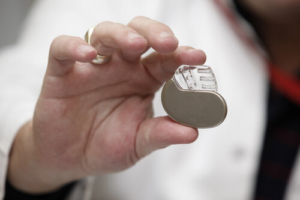Has your doctor recommended that you undergo a cardioversion procedure to treat AFib symptoms? You may be wondering: what is cardioversion? In addition, how can you know if it is the best treatment option for your needs?
Like any other health condition, finding the correct treatment for every patient with atrial fibrillation is personal to their unique medical history. To decide the best possible treatment plan for each patient, your cardiologist or electrophysiologist considers various factors, including the duration and severity of your AFib symptoms, your additional medical comorbidities, current medications, and more.
In some cases, patients with AFib can reduce their symptoms through lifestyle changes and medications — but for those with more persistent symptoms, procedures such as a cardioversion may be needed to improve symptoms.
This article covers everything you need to know about cardioversions — a popular and effective treatment option designed to (literally) shock your heart out of AFib, returning it to a normal sinus rhythm.
While this is not a procedure offered to all AFib patients, it is important for anyone diagnosed with atrial fibrillation to understand their treatment options should their condition progress over time. Covering everything from what to expect before, during, and after a cardioversion, this article will also answers some of the most frequently asked questions that I get from patients considering undergoing this procedure for their AFib symptoms.
With this in mind, let’s jump right into it to learn everything you need to know about cardioversion procedures for atrial fibrillation:
What is a Cardioversion?
For most of my patients, when I bring up the idea of treating their AFib with a cardioversion, their minds immediately jump to an intense and hectic medical scene from television.
In a moment of panic when a patient’s heart stops, the medical staff are running around the room, yelling medical terms, while they use large electrical paddles to shock the patient’s heart back to life. EVERYONE CLEAR!!
In reality, a cardioversion does involve many of the same concepts and technology, but it is a lot less dramatic.
During the usually very calm procedure, an electrical current is applied to your heart through your skin to reset your heart in an attempt to bring your heart out of AFib and back into normal sinus rhythm. I usually tell my patients that it’s kind of like when your computer isn’t working — you turn it off and on again to reset it. This is the same principle as what a cardioversion does to restore the normal rhythm of your heart.
What Does a Cardioversion Treat?
Acting like a jump-start to the heart to restore normal sinus rhythm, some of the most common heart arrhythmias that a cardioversion procedure can treat include:
-
Atrial fibrillation and atrial flutter
-
Atrial tachycardia
-
Ventricular tachycardia
-
Ventricular fibrillation
-
Supraventricular Tachycardia or SVT
Who is a Candidate for a Cardioversion?
As I mentioned before, not all treatment options for AFib will be a good fit for every patient. Because of this, your cardiology team will work with you to determine if moving forward with a cardioversion procedure will be the best course of action for your needs.
Generally speaking, here are some of the most common criteria that I ensure my patients meet before I recommend cardioversion as a treatment option:
-
The patient is diagnosed with persistent atrial fibrillation (meaning they experience their AFib symptoms constantly, not just from time to time). Usually a patient is in continuous atrial fibrillation for at least 7 days to be considered in persistent atrial fibrillation.
-
Their persistent AFib symptoms are relatively new (a few months to a year). Patients experiencing persistent AFib symptoms for multiple years are less likely to get the results they want from a cardioversion. The longer someone is in atrial fibrillation, the lower the success rate of a cardioversion procedure.
-
The patient has a healthy functioning heart (aside from AFib symptoms) and would be expected to be able to handle the anesthesia and procedure without complications.
On the other hand, there are some reasons why a patient may not be a good candidate for cardioversion. Some examples include:
-
Living with a heart arrhythmia caused by drug toxicity
-
Having a confirmed blood clot inside of the heart
-
Being unable to take anticoagulation medications
-
Having another more serious health condition or infection
If you are unsure if you are a good candidate for cardioversion, be sure to speak to your primary care provider and cardiology team.
What to Expect During a Consultation with Your Doctor
If you or someone you love is considering undergoing a cardioversion to treat AFib symptoms, the first step is meeting with a cardiologist or electrophysiologist to potentially schedule the procedure. During this appointment, your provider should provide the following important pieces of information:
-
A brief overview of what will happen during the procedure
-
Instructions on what to do before and after a cardioversion
-
The potential risks and benefits of having the procedure
During this appointment, your doctor will also ask you to sign an informed consent form for the procedure, indicating that you are aware the potential risks of undergoing a cardioversion. Before signing, it is important to ask your provider any additional questions you may have so you feel clear and comfortable about why you are choosing to have the procedure.
Throughout this appointment, your doctor should also ask you a series of questions to determine if you are an ideal candidate for cardioversion. Examples of questions you could be asked and should have an answer to include:
-
How long have you been living with atrial fibrillation?
-
How severe are your symptoms, and how often do you experience them?
-
What AFib treatments are you currently taking?
-
Do you have any other diagnosed medical conditions?
-
Do you take any medications?
-
Have you previously had surgery or been under anesthesia? Did you have any reactions?
The Potential Risks and Complications of Cardioversion
If you elect to go ahead with a cardioversion for your AFib symptoms, it is critical that you understand the potential risks and complications that can occur from this decision.
From my experience, most cardioversion procedures are very straightforward. Historically, when I have a patient who I consider to be too unwell to undergo a more invasive procedure such as a catheter ablation for their AFib, I opt to try a cardioversion first.
This being said, there are always risks associated with any medical procedure. Some of the most common risks and complications of cardioversion that you should be aware of include:
-
The development of a different (often less dangerous) heart arrhythmia
-
Short-term low blood pressure
-
Skin damage (redness or rash) at the site of the electrodes
-
Heart damage (which is usually short-lived and does not cause symptoms)
-
Sudden cardiac failure
-
Dislodging of a blood clot, which can cause a stroke or pulmonary embolism. Usually a pre procedure evaluation is performed to exclude the presence of a blood clot prior to a cardioversion.
If you have any questions about your personal risk factors for this procedure, be sure to speak to your primary care provider and electrophysiologist for further information.
How to Prepare for a Cardioversion Procedure
Before your cardioversion, your doctor should provide you with a detailed list of pre-operative things to organize or prepare ahead of time. Some of the most things that I mention to my patients include:
-
Take your medications as per usual — Unless you have been told otherwise, take your medications (including blood thinners) as per usual on the day of your procedure. Do your best to take any oral medications with only a small sip of water so your stomach can be empty during the cardioversion.
-
Do not eat or drink on the day of your procedure — Having an empty stomach is a necessary safety precaution for patients who undergo sedation. Do not eat or drink anything (aside from small sips of water for pills) for usually 12 hours before your procedure. Failure to do this can result in the cancellation of your cardioversion.
-
Arrange a ride to and from your procedure — If you are having sedation for your procedure, you will not be able to drive for 24 hours following your cardioversion. Ensure you have a reliable ride to and from your appointment to get home safely.
-
Bring a list of your medications/medical history if possible — Whenever possible, bringing a short list of your medical conditions and medications is a great asset for the new medical staff you may be meeting on the day of your procedure.
If you have any additional questions about how to prepare for your cardioversion, be sure to contact your provider.
What Happens During a Cardioversion Procedure
Once you arrive at the clinic or hospital for your procedure, the following steps will occur:
-
Medical staff will check you in, confirm your identity, and review your consent form. This is a great chance to ask any final questions you may have about the procedure.
-
Next, you will meet your anesthetist, who will start an IV line in your arm. This will be used to give you the medications needed to feel and remember nothing during the procedure.
-
Next, ECG electrodes and cardioversion pads will be applied to your chest. They are made with a sticky adhesive that can cause some redness to the skin after the procedure. Also an oxygen level sensor is usually placed on your finger to monitor your oxygen levels during the procedure.
-
Once everything is set, you will receive the sedation medications to drift off into a deep sleep.
-
While asleep, your cardiologist or electrophysiologist will use a cardioverter machine (defibrillator) to deliver a calculated shock to your heart. This is designed to provide a strong electrical rhythm, which will hopefully reset your heart rhythm and help your heart return to normal sinus rhythm. In some cases, more than one shock is needed to get the desired result.
What to Expect After a Cardioversion
In most cases, a cardioversion procedure only takes a few minutes to complete. The majority of the time that a patient spends in the hospital for this procedure is spent during pre and post-procedure monitoring and set-up!
Once complete, you will be monitored by trained medical staff until you have awoken from their sedation. You will have your vital signs monitored during this time and will likely have an ECG done to better understand the impact the procedure had on your heart rhythm and to confirm you are in normal sinus rhythm after the procedure.
If everything is looking good, you will likely be able to go home within an hour of your procedure. Due to the sedation, you should not drive or operate heavy machinery for 24 hours following your procedure. Other important things I encourage my patients to do during the recovery period include:
-
Take the remainder of the day off to rest. If they feel well the following day, they can participate in their normal daily activities as tolerated.
-
Drink and eat like normal following the procedure. Avoid alcohol and nicotine for 24 hours following your sedation to prevent additional confusion and fatigue.
-
Document any changes in your heart rhythm or the development of any symptoms. Call or contact your provider if you notice significant changes in your symptoms that you are concerned about.
Frequently Asked Questions about Cardioversion
Are You Awake During a Cardioversion?
Depending on the number of medical shows or crazy YouTube videos that you have watched, it is easy to believe that your cardioversion experience will be intense and possibly traumatic. But, in actuality, scheduled cardioversions (which are the most common type done for the treatment of AFib) are very calm and pre-planned events. When I perform this procedure on my patients, I always ask for an anesthetist to be present, allowing my patients to benefit from light or heavy sedation so they are not awake and do not remember the procedure.
Commonly used sedation medications during a cardioversion are propofol or etomidate. Both of these medications are potent, but short acting medications. This allow a patient to quickly go into a deep sleep during a cardioversion procedure, and the medications wear off usually within a few minutes.
Is a Cardioversion Painful?
During a planned cardioversion with proper anesthesia, you will not feel any pain during the procedure. In some cases, some patients experience chest pain as part of their recovery, which is unrelated to their heart function. This pain (which can also come with some redness or a rash at the site of the electrical pads) is often very mild and will disappear after a few days. This type of chest pain is usually confined to the skin where the cardioversion pads were placed on not coming from the heart itself.
Outside the rare emergency cardioversion where a patient is clinically unstable, the grand majority of cardioversions are elective and scheduled ahead of time. In these situations, heavy sedation is frequently used so that a patient does not feel the pain of a cardioversion.
How Successful are Cardioversions?
There are many different factors that can impact the success rate of your cardioversion procedure. Statistically, between 50-90% of all cardioversion procedures produce positive short-term results (and in my experience, this number is much closer to the higher end of the range). However, long-term results heavily depend on the patient’s overall health, lifestyle factors, and the severity and duration of their AFib symptoms before the procedure.
In addition, pretreatment with anti-arrhythmic medications such as amiodarone or sotalol, can also improve the success rate of a cardioversion. Also, treatment with these anti-arrhythmic medications after a cardioversion can also improve the long-term success rate of a cardioversion.
How Long Does a Cardioversion Take?
An elective cardioversion is typically scheduled as an appointment with your cardiologist or electrophysiologist. Once the anesthetist has placed your IV and given you some sedation medication to make you more comfortable, the actual cardioversion procedure takes only a few seconds to complete. After you have woken up from the sedation and are in a stable cardiac rhythm, you can usually go home the same day (though you must have a ride home if sedation is used). In my experience, the entire cardioversion procedure: the preparation, the cardioversion procedure itself, and post procedure recovery is usually about two hours.
How Much Energy is Used During a Cardioversion?
There are different levels of energy available for a cardioversion procedure. The amount of energy is determined based on the patient’s size — people with more weight are going to require higher energy because you just have to get through more tissue to actually try to reset their heart. Additionally, the longer a person is in atrial fibrillation, the more energy is required to successfully cardiovert the heart. For example, someone who has been in persistent atrial fibrillation for a few weeks will typically require less energy than someone that has been in persistent atrial fibrillation for over a year.
Generally speaking, I commonly use 200 Joules of energy for the cardioversion procedures I perform on my AFib patients. For patients with significant obesity or in patient with long standing persistent atrial fibrillation, I will use higher energy, usually 360 Joules of energy.
How Many Cardioversion Procedures Can One Person Have?
There is no maximum number of cardioversion procedures that a person can have — though if more than a couple of attempts have been performed without good results, it is likely that it is not the correct treatment option for that specific patient.
Putting It All Together
So, as we can see, choosing to undergo a cardioversion procedure can be an effective and relatively safe option for patients living with persistent atrial fibrillation. But, just like any other medical treatment, there are always risks, complications, and individual factors that should be considered before you agree to go ahead with this therapy for AFib.
I hope you found this article to be a helpful resource for learning more about AFib treatment options. If you are interested in learning more about the potential benefits of undergoing cardioversion for your AFib symptoms, I recommend speaking to your primary care provider and cardiology team.
The Best Atrial Fibrillation Book
Your Complete Guide To AFib: The Essential Manual For Every Patient With Atrial Fibrillation
$15.95 (as of April 27, 2024 10:32 GMT -06:00 - More infoProduct prices and availability are accurate as of the date/time indicated and are subject to change. Any price and availability information displayed on [relevant Amazon Site(s), as applicable] at the time of purchase will apply to the purchase of this product.) The A to Z guide on everything you need to know about atrial fibrillation. Written by AFib expert Dr. Percy Morales MD. Over 120 pages of essential information on medications, procedures, and lifestyles modifications for AFib. Easy to read for every patient.
Shop AFib Products on Amazon
KardiaMobile 6-Lead Personal EKG Monitor – Six Views of The Heart – Detects AFib and Irregular Arrhythmias – Instant Results in 30 Seconds – Works with Most Smartphones - FSA/HSA Eligible

KardiaMobile 1-Lead Personal EKG Monitor – Record EKGs at Home – Detects AFib and Irregular Arrhythmias – Instant Results in 30 Seconds – Easy to Use – Works with Most Smartphones - FSA/HSA Eligible

Apple Watch Series 9 [GPS 41mm] Smartwatch with Storm Blue Aluminum Case with Silver Sport Band M/L. Fitness Tracker, Blood Oxygen & ECG Apps, Always-On Retina Display

Fitbit Sense 2 Advanced Health and Fitness Smartwatch with Tools to Manage Stress and Sleep, ECG App, SpO2, 24/7 Heart Rate and GPS, Shadow Grey/Graphite, One Size (S & L Bands Included)

OMRON - Complete Wireless Upper Arm Blood Pressure Monitor + EKG - Built-in Bluetooth Technology

Omron Hem 7361T Bluetooth Digital Blood Pressure Monitor with Afib Indicator and 360° Accuracy Intelliwrap Cuff for Most Accurate Measurements (White)

EMAY Portable ECG Monitor | Record ECG and Heart Rate Anytime Anywhere | Stand-Alone Device with LCD Screen and Storage | No Subscription Required

Samsung Galaxy Watch 6 44mm Smartwatch with HR Zones, Sleep Coaching, Heart Monitor - Graphite

Natural Rhythm Triple Calm Magnesium 150 mg - 120 Capsules – Magnesium Complex Compound Supplement with Magnesium Glycinate, Malate, and Taurate. Calming Blend for Promoting Rest and Relaxation.

Pure Encapsulations Magnesium (Glycinate) - Supplement to Support Stress Relief, Sleep, Heart Health, Nerves, Muscles, and Metabolism* - with Magnesium Glycinate - 180 Capsules


















![Apple Watch Series 9 [GPS 41mm] Smartwatch with Storm Blue Aluminum Case with Silver Sport Band M/L. Fitness Tracker, Blood Oxygen & ECG Apps, Always-On Retina Display #1](https://m.media-amazon.com/images/I/311xwtp4mFL._SL100_.jpg)
![Apple Watch Series 9 [GPS 41mm] Smartwatch with Storm Blue Aluminum Case with Silver Sport Band M/L. Fitness Tracker, Blood Oxygen & ECG Apps, Always-On Retina Display #2](https://m.media-amazon.com/images/I/41j+8AaUGsL._SL100_.jpg)
![Apple Watch Series 9 [GPS 41mm] Smartwatch with Storm Blue Aluminum Case with Silver Sport Band M/L. Fitness Tracker, Blood Oxygen & ECG Apps, Always-On Retina Display #3](https://m.media-amazon.com/images/I/41jIyxZitnL._SL100_.jpg)
![Apple Watch Series 9 [GPS 41mm] Smartwatch with Storm Blue Aluminum Case with Silver Sport Band M/L. Fitness Tracker, Blood Oxygen & ECG Apps, Always-On Retina Display #4](https://m.media-amazon.com/images/I/41IpNJERjCL._SL100_.jpg)
![Apple Watch Series 9 [GPS 41mm] Smartwatch with Storm Blue Aluminum Case with Silver Sport Band M/L. Fitness Tracker, Blood Oxygen & ECG Apps, Always-On Retina Display #5](https://m.media-amazon.com/images/I/31o17yhfYpL._SL100_.jpg)

















































